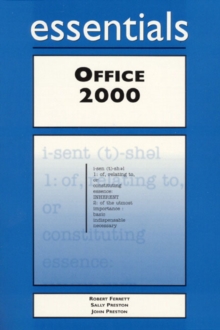For courses in Microsoft Office Professional for Windows, Access for Windows, Excel for Windows, PowerPoint for Windows, and Word for Windows.
Essentials courseware is anchored in the practical and professional needs of all types of students.
The series has been completely revamped as the result of extensive usability testing conducted by students with multiple levels of computer knowledge.
The Essentials series is conceived as a 'learning system' that combines graphics, instructions, experience, reinforcement, and problem solving.
It consists of modular lessons that are built around a series of numbered, step-by-step procedures that are clear, concise, and easy to review.
Explanatory material is interwoven before each lesson and between the steps.
Additional features, tips, pitfalls, and other related information are provided at exactly the right place.
They are easily recognizable elements that stand out from the main flow of the tutorial.
Icons are designed to match the Microsoft Office theme.The end-of-chapter exercises have been carefully graded from the routine Checking Concepts and Terms to tasks in the Discovery Zone that gently prod students into extending what they have learned into areas beyond the explicit scope of the lessons proper.
Substantial Focus On Learning and How To Learn. * Guided use of onscreen Help within lessons and end-of-project exercises. * Helps students 'learn to learn' on their own to keep up with the ever-expanding feature set of Microsoft Office.
Shows them how to discover the right procedures or answers by exploiting the many resources that are already within the application.
Hands-On Exercises: Expanded into Three Levels. * Skill Drill exercises--Reinforce project skills. Each skill that is reinforced is the same, or nearly the same, as a skill presented in the project.
Detailed instructions are provided in a step-by-step format. * Enables students to check their comprehension, evaluate their progress, and practice what theyve learned. * Challenge exercises--Expand upon or are related to skills presented in the lessons.Each exercise provides a brief narrative introduction, followed by instructions in a numbered step format that are not as detailed as those in the Skill Drill section.
Some contain references for students to apply tips discussed in Nice to Know, Need to Know, or Help. * Helps students learn to think on their own and fosters the 'near transfer' of learning. * Discovery Zone exercises--Require advanced knowledge of topics presented in Essentials lessons, the application of skills from multiple lessons, or self-directed learning of new skills.
Some contain references for students to apply tips discussed in Nice to Know, Need to Know, or Help. * Emulates real-world experience by encouraging self-directed learning of new skills.
Beginning of the Project. * Objectives--Specific topics covered in the lessons. * Gives students short-term, attainable goals for each project. * Key Terms--New terminology defined and discussed in the project. * Helps students to become familiar with the terminology used. * Why Would I Do This?--Introductory section telling students why a project is useful to them.* Shows students why a project is useful to them and what they can do with the knowledge they obtain. * Visual Summary--Screen shots and sample documents to illustrate what students will learn in the project. * Illustrates the concepts and features students will learn in the project and helps to keep them motivated.
Lessons. * Lessons--Projects broken down into lessons that correspond with objectives. * Gives students the project broken down into lessons that correspond with objectives. * Step-by-Step Instructions--Instructions, along with explanation, to guide students as they learn new features. * Guides students as they learn new features, and lets them 'learn-by-doing.' * If You Have Problems-- Trouble-shooting tips that anticipate common pitfalls. * Helps students anticipate or solve common problems quickly and effectively. * Need to Know--Essential notes and information necessary to apply features. * Provides students with essential tips for performing the task and using the application more effectively. * Nice to Know--Additional tips to become more proficient in using the software.* Provide students with extra tips, shortcuts, alternative ways to complete a process, and special hints about using the software.
Checking Concepts and Terms. * True/False Questions --With reference to lesson where topic is covered. * Multiple Choice Questions--With reference to lesson where topic is covered. * Screen ID--Where students identify elements of the screen and within documents. * Discussion Questions--That make students apply critical-thinking skills to further understand concepts and features. * Helps students check their comprehension and assess their retention.

